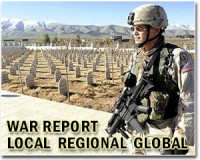| . |  |
. |
Washington (AFP) Jan 16, 2011 Twenty years after the brief but bloody Gulf War, the United States looks back on a campaign that averted a second Vietnam as it braces for another potential quagmire in Afghanistan. Operation Desert Storm, a 40-day war that pounded Saddam Hussein's forces out of Kuwait, was part of a military doctrine spelled out by the most senior military officer at the time -- General Colin Powell -- only to be forgotten decades later in the sands of Iraq and the mountains of Afghanistan. Scarred by a humiliating defeat in Vietnam where he had served as a young officer, Powell laid out clear criteria before deploying US troops to the battlefield: clearly identified political and military goals, vital US national security interests at stake and broad US and international support. Once he felt those conditions had been met, Powell sought and obtained presidential approval for an "overwhelming force" to ensure victory, explained military expert Larry Korb of the Center for American Progress. The 1990-1991 Gulf War saw a rigid application of the "Powell Doctrine," which the general later explained meant exhausting all "political, economic and diplomatic means." Over 500,000 Coalition troops from dozens of allied nations were poured into the Gulf for the war that began with an extensive month-long aerial campaign followed by 100 hours of operations on the ground with the sole objective of ousting Saddam from his wealthy neighbor. But this rigid doctrine struggled to fit the nation-building and humanitarian military missions of the 1990s that unfolded in places like Somalia and the Balkans. It was eventually set aside, explained analyst Michael Cohen. The arrival of new technologies and the growing role of intelligence and communications on the battlefield triggered a "revolution in military affairs," according to Korb. Conflicts were seen as requiring fewer boots on the ground than ever before. In 2001, Special Operations forces and CIA agents coupled with aerial bombardments ousted the Taliban from Afghanistan and two years later, fewer than 150,000 US troops were deployed to get rid of Saddam for good. But in both cases, there was no initial plan for the long months and eventually years that followed to put Afghanistan and Iraq back on their feet. Korb called it a "deliberate" move on then-Defense Secretary Donald Rumsfeld's part. "He didn't want any part of nation-building, plus the neocons (neoconservatives) believed (preeminent Iraqi politician Ahmed) Chalabi would take over. They didn't really do any planning for the post-war period," he added. In Iraq and Afghanistan alike, insufficient numbers of US and coalition troops coupled with governments too weak to bring their authority to bear on the population faced a growing insurgency that forced the United States to accept a long-term and reinforced military presence. A troop surge that brought to 170,000 the number of US troops in Iraq in 2007, coupled with the so-called Sunni Awakening that saw tribal leaders unite to maintain security and a ceasefire by Iraq's largest Shiite militia the Mahdi Army eventually helped contain the violence. In Afghanistan, President Barack Obama has escalated the war against the Taliban and other insurgent groups, swelling US troop numbers to 100,000 with plans to begin drawing down US forces in July and transfer security to Afghan forces in 2014. Cohen sees these wars as a reaffirmation of the Powell Doctrine. "Perhaps the most important, yet unstated element of the Powell Doctrine was the understanding that open-ended conflicts defined by anti-guerrilla and counterinsurgency operations were rarely in the US national interest," he wrote in an article for the New America Foundation.
Share This Article With Planet Earth
Related Links
 Philippine government, insurgents meet in Oslo in peace bid
Philippine government, insurgents meet in Oslo in peace bidOslo (AFP) Jan 14, 2011 Representatives of the Philippine government and the country's communist rebels gathered in Oslo Friday for informal talks aimed at preparing for an upcoming relaunch of a peace process put on ice in 2005. "The aim of this meeting is to prepare in the best possible fashion for the formal peace negotiations that are set to begin next month," Norwegian facilitator and diplomat Ture Lundh told ... read more |
|
| The content herein, unless otherwise known to be public domain, are Copyright 1995-2010 - SpaceDaily. AFP and UPI Wire Stories are copyright Agence France-Presse and United Press International. ESA Portal Reports are copyright European Space Agency. All NASA sourced material is public domain. Additional copyrights may apply in whole or part to other bona fide parties. Advertising does not imply endorsement,agreement or approval of any opinions, statements or information provided by SpaceDaily on any Web page published or hosted by SpaceDaily. Privacy Statement |